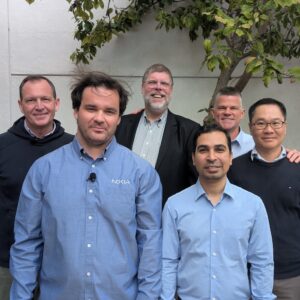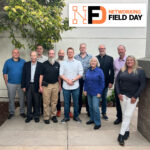|
|
 Nokia Presented at Networking Field Day 39 |
This Presentation date is November 5, 2025 at 13:30-15:30.
Presenters: Andy Lapteff, Bruce Wallis, Clayton Wagar, Rupak Jha, Scott Robohn
Follow on Twitter using the following hashtags or usernames: #NFD39
Introduction to Nokia with Andy Lapteff
Watch on YouTube
Watch on Vimeo
Andy Lapteff, a network engineer who became a product marketing manager for Nokia Data Center, introduced his presentation by sharing his personal journey. He admitted that, like many, he previously only knew Nokia for its indestructible cell phones and was unaware of its significant presence in the data center market. It was at a previous Tech Field Day event, attending as a delegate, that he learned Nokia had been building mission-critical networking infrastructure for decades for entities like air traffic control and power grids, and was now applying those same principles of ultra-reliability to the data center. This revelation was so compelling that it motivated him to join the company.
Lapteff contrasted Nokia’s approach with his own past experiences working midnights in a network operations center (NOC), where networks were complex, fragile, and “on fire all the time,” and a “no change Fridays” mentality was common. His motivation at Nokia is driven by the memory of those challenges, aiming to build more robust and reliable networks for data center operators. He expressed genuine excitement for the value Nokia provides, which he feels is real and tangible, unlike other vendor jobs he has held.
The presentation set the stage for a deeper dive into the future of networking, particularly focusing on the often-confusing landscape of AI, AIOps, and the different levels of network autonomy. Lapteff noted that while the industry is largely at a manual or low-automation level, Nokia is pushing toward full autonomous operations. He concluded by previewing the day’s key topics, promising impressive demonstrations on “Agentic AI ops in action,” AI-driven root cause analysis, the automation of AI back-end fabrics, and a much-anticipated update on Nokia’s potential support for non-Nokia hardware.
Personnel: Andy Lapteff
Exploring the Power and Potential of Enhanced AIOps with Nokia
Watch on YouTube
Watch on Vimeo
Clayton Wagar, leading the AI practice for Nokia’s IP division, framed his presentation as creating a “through line” connecting the history of network operations to its AI-driven future. Recalling his own start managing a 911 data center with manual, CLI-driven processes, he traced the evolution of the industry as operators moved from mastering workflows in their heads to writing them down and eventually using automation. Wagar emphasized that as AI is introduced, it’s crucial to be prescriptive about its use and to understand its two main facets: the “plumbing” aspect of building massive networks to support AI, and the application of AI tools to network operations itself.
To illustrate the challenge of applying AI to mission-critical systems, Wagar told a story about a 1943 discussion at Bell Labs between Claude Shannon and Alan Turing. They faced a choice: build a computer like a human brain (a neural network) or like an adding machine (a deterministic system). They chose the adding machine, not only because the technology for neural networks didn’t exist, but critically because telcos and governments required predictable, deterministic outputs, not a system that might hallucinate. This historical context highlights the primary challenge Nokia addresses today: reducing AI hallucinations to make the technology safe for essential, real-world networks where reliability is paramount.
Wagar then connected this to the modern concept of autonomous networks, such as the levels defined by TM Forum. He proposed that these frameworks were largely developed before modern AI and assumed a deterministic path, whereas AI introduces a new, separate plane of capability. He pointed to Google’s public journey toward autonomous networking, which leverages custom-built AI agents to move beyond simple event-driven workflows to a truly autonomous SRE model. Wagar concluded by positioning Nokia’s strategy as learning from these leaders, blending AI and traditional automation to inform their product development and establish new best practices for the industry.
Personnel: Clayton Wagar
Nokia Event-Driven Automation (EDA) Multi Vendor – Deliver on the Promise
Watch on YouTube
Watch on Vimeo
Bruce Wallis, Product Manager for Nokia’s EDA (Event-Driven Automation) platform, began by revisiting the core assertions made when the product was unveiled a year prior. He reiterated that EDA was built on the same successful principles as Kubernetes: abstraction and a declarative model. The goal was to apply this logic to networking, creating a ubiquitous platform that could define a unit of work for the network, just as Kubernetes did for compute workloads. This approach aims to normalize networking primitives like interfaces and BGP peers, allowing an operator to declare the desired end state without scripting the specific sequential steps, letting the platform handle the how.
The presentation’s main focus was delivering on the multi-vendor promise made at the previous event. Wallis conducted a live demo, bootstrapping an eight-node, dual-stack fabric underlay using a single 58-line YAML file. This high-level abstract definition was automatically reconciled by EDA, which then generated and pushed the correct, vendor-specific configurations to four different operating systems running on the leaf switches: Nokia SR Linux, Nokia SROS, Cisco Nexus, and Arista EOS. This demonstrated the platform’s ability to manage a heterogeneous network through one common model.
Finally, Wallis addressed other key platform features, including the ability to bubble operational state up into the abstract model, allowing operators to view the “health” of the entire fabric rather than just individual components. He also clarified for delegates that while he used YAML for demo speed, the platform is fully operable via a form-based UI for users unfamiliar with programmatic inputs. He concluded the demo by successfully deploying a complex EVPN overlay network across the newly built, multi-vendor underlay, again using a single, simple declarative input.
Personnel: Bruce Wallis
Delivering Nokia Enhanced AIOps with the Right Foundations
Watch on YouTube
Watch on Vimeo
Bruce Wallis pivoted the discussion to Nokia’s AIOps capabilities, centered on a new natural language interface called Ask EDA. This feature, which resembles a ChatGPT for the network, allows operators to interact with the EDA platform through a simple chat box. The core idea is to abstract the complexity of network operations, enabling users to ask plain-English questions, such as “list my SRL interfaces” or “is BFD enabled?”, and receive back live, structured data, tables, and even on-the-fly visualizations like pie charts and line graphs. This approach removes the need for operators to understand the complex underlying Yang models or schemas for each vendor, as the AI handles the translation from human language to machine query.
The right foundation for this capability, as Wallis explained, is not a single, monolithic, trained model, but a flexible agentic AI framework. In this model, the central LLM acts as a brain that coordinates a set of pluggable agents, or tools, each with a specific function. The most powerful aspect of this design is its real-time extensibility. Wallis demonstrated this by first showing the AI failing to understand a request to “enable the locator LED.” He then installed a new support application from EDA’s App Store; when asked again, the AI agent immediately recognized and used this new tool to successfully execute the command. This app-based approach allows Nokia to add new troubleshooting workflows and capabilities on the fly, without retraining the model or upgrading the core platform.
This agentic framework is applied directly to troubleshooting and operations. Wallis showed how “Ask EDA” can be used to investigate “deviations,” or configuration drift, where the running config no longer matches the intended state. In another example, with a BGP peer alarm active, the AI was asked to investigate. It used its agents to query various resources, analyze the topology, and correctly identified that the BGP manager process had crashed and restarted, providing a direct link to the deviation. Wallis emphasized that this method of using the LLM to query factual data from live telemetry and tools is how Nokia is addressing the problem of hallucinations, ensuring the AI’s answers are grounded in reality.
Personnel: Bruce Wallis
Root Cause Analysis with Nokia AI Operations Automation
Watch on YouTube
Watch on Vimeo
Clayton Wagar introduced Nokia’s AI-driven approach to root cause analysis, focusing on solving difficult day-two operational challenges. The presentation highlighted the chronic pain of hidden impairments or gray failures, where traditional monitoring systems fail because physical links appear active while protocols or services are down. The goal of Nokia’s deep RCA tool is to move beyond simple port-up/port-down alarming by correlating end-to-end application connectivity (from VM to VM) with all layers of the network, including the underlay, overlay, and control plane, to dramatically compress troubleshooting time.
A live demonstration was shown on the EDA SaaS platform using a real hardware Spine-Leaf network. The team introduced a gray failure by impairing a fiber link in a way that kept the interface status “up” but caused the BFD and BGP protocols to fail. Wagar explained that the AI’s multi-agent workflow correctly diagnosed this. Instead of using one large, monolithic model, a planning model first determines which tool-calling agents to deploy. These agents gather specific, relevant data from logs, topology, and configuration, which is then filtered and passed to a reasoning model. This agentic-based curation of data is Nokia’s key to reducing costs and avoiding the AI hallucinations that would otherwise be a risk in mission-critical networks.
The tool’s capabilities were further demonstrated by successfully identifying a classic, hard-to-find MTU mismatch. Another key feature highlighted was the “Time Machine,” which allows an operator to select a past timeframe, such as thirty minutes prior to an event, and run the same AI-driven root cause analysis on the historical data from that moment. The entire process concludes with the AI generating a comprehensive report that provides a human-readable summary, a confidence score, and the specific evidence gathered by the agents, effectively solving a complex logic puzzle that would have taken an engineer hours or days to manually diagnose.
Personnel: Clayton Wagar
The Age of Operations: Third Party Views of DCF Innovation
Watch on YouTube
Watch on Vimeo
Scott Robohn of the consulting firm Solutional provided a third-party, operational perspective on data center innovation, based on a collaboration with The Futurum Group and Nokia. He introduced his background as a former network engineer and Tech Field Day delegate, now focused on NetOps and AI adoption. Robohn’s central thesis is that with AI driving new infrastructure builds and hardware becoming normalized, the next major performance gains in data centers will come from a relentless focus on improving operations. The joint project between Solutional, Futurum, and Nokia aimed to validate this by looking at AI’s dual role: both as a driver for new network infrastructure and as a set of tools to be used for network operations.
Robohn detailed the market trends shaping this new age of operations, starting with AI as a durable technology driving massive fabric build-outs by hyperscalers and a new class of NeoCloud providers. He defined NeoClouds as specialized providers focused on renting expensive, complex GPU-interconnect infrastructure for workloads like model training and video rendering. He then argued that as data center hardware has normalized around merchant silicon and stable architectures like Spine-Leaf, the hardware itself is no longer the key differentiator. This consistency makes automation more achievable and shifts the entire industry’s focus to operations as the critical area for innovation and reliability.
To validate this operational focus, the project stood on four legs. First, a Futurum reliability survey which found that network reliability is the number one purchasing criterion for data center infrastructure, far outweighing cost, and that human error remains a major issue. Second, a collaboration with Bell Labs on a reliability model, which concluded the most significant reduction in downtime comes from fixing operations-related issues. Third, interviews with Nokia’s own 80,000-employee internal enterprise IT team, who are successfully migrating their complex, high-stakes manufacturing and office networks to Nokia’s SR Linux and EDA platform. Finally, general market engagement confirming a palpable, industry-wide appetite for a new class of automation and AIOps tools.
Personnel: Scott Robohn








